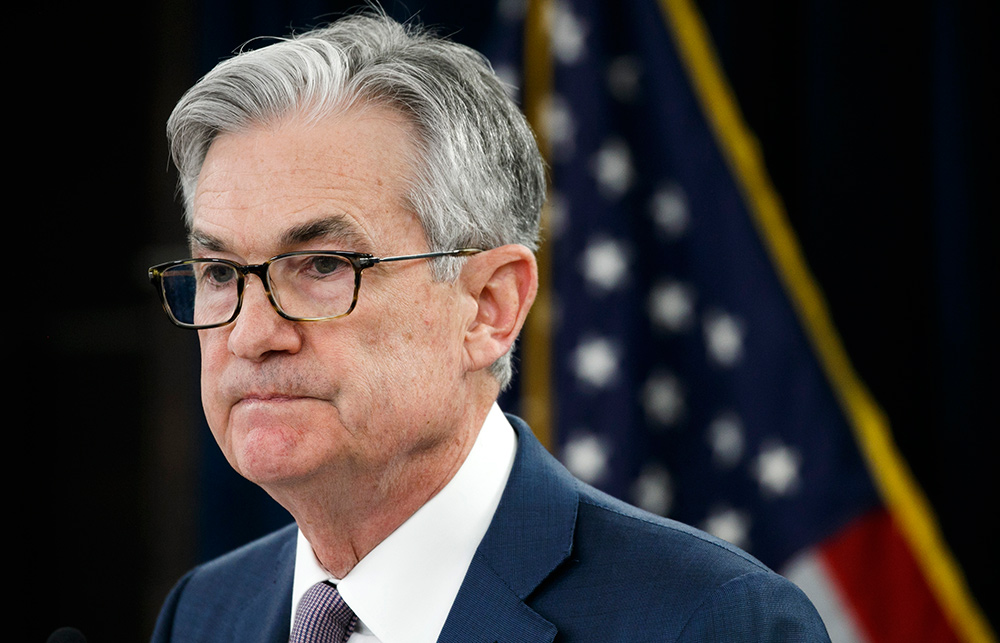美联储:2022年之前利率将在零点徘徊

美联储称其将继续增持债券,以便在经济衰退期间保持借贷利率的低位运行,并支撑美国经济。它还表示,几乎美联储的所有决策者都预测2022年之前不会上调利率。
美联储已经将其短期基准利率削减至零点附近。在今后两年多的时间中将利率保持在超低水平有助于消费者和企业充分地借贷和消费,从而维持受企业关闭和高失业率拖累的经济。
美联储在6月10日的政策会议结束后发表的声明中提到,新冠疫情导致了经济活动的大幅下滑和失业率的激增。
美联储官员预计,经济在今年将收缩6.5%,与其他机构的预测一致,在2021年将增长5%。该机构还预测失业率将达到9.3%,于今年年底达到上一次经济衰退的峰值附近。这个数字当前为13.3%。
在6月10日下午召开的虚拟新闻发布会上,美联储主席杰罗姆•鲍威尔预计将传达这样一个信息:尽管经济最近出现了潜在的恢复迹象(包括政府发布的报告显示,雇主在5月出人意料地提供了更多的岗位),但它依然需要超常手段的帮助。
自3月以来,美联储下调了其短期基准利率,购买了2.1万亿美元的国债和抵押债券,从而将现金注入市场,并推出了九项借贷方案,以保持信贷的顺畅流动。大多数分析师预计,美联储在采取任何进一步行动之前,也就是9月的碰面会之前,会暂停行动,并评估经济格局。
美国股市在经历3月令人目眩的大跌之后,于近期几乎大涨至其疫情前的水平,业界认为美联储的上述行动功不可没。
美联储一直在增持企业债券,并借此重振此类债券市场,此举也给企业释放了一个明确的信号——可以继续借贷。美联储的动议还包括购买州政府和地方政府的债券,以支撑市级债券市场,这在美国历史上尚属首次。
众多经济学家称,这些举措通过保持借贷的流动性,防止了经济下行的进一步恶化。上周,经济衰退的官方认定机构全美经济研究局宣称,美国经济在2月进入了衰退。
美联储在3月和4月采取的应急行动旨在努力确保经济挺过企业关闭期。它如今面对的一个挑战在于,随着各大企业相继重启其业务,自己应该采取什么样的措施才能刺激经济复苏。
在上个月发表的致辞中,美联储副主席理查德•克拉瑞达强调,疫情爆发依然会对经济构成威胁。不过他还指出,美联储官员希望再搜集几个月的数据,来衡量经济的健康度,然后决定下一步该怎么做。
如今,美联储官员在如何采取进一步行动方面可能感受到了些许压力,因为很少有投资者认为他们会在近期对基准利率进行调整。尽管从理论上来讲,美联储可以启用负利率,但鲍威尔基本上拒绝了这个选项。
然而,美联储还能采取其他的举措。它可以明确说明自己准备让短期利率在零点附近徘徊多长的时间,以及自己准备购买多少债券来压低长期利率。这个指引能够通过降低投资者推高长期利率的可能性来帮助经济。
2011年,随着经济艰难地摆脱2008年至2009年的衰退阴影,美联储首次为任何可能的利率上调设定了一个具体的日期。它称“至少在2013年中期之前”让利率保持低位运行。该日期在2015年中期之前又延期了两次。
然而,美联储在2012年替换了其带有具体日期的指引,并称其至少会在“失业率低于6.5%之前”让利率继续在零点附近徘徊。大多数经济学家认为这一举措更为有效,因为它首肯了一件事情:在经济恢复增长之前,美联储不会收紧信贷。
美联储自3月以来购买了2.2万亿债券,当时投资者急于抛售国债和其他证券来换取现金,金融市场也因此而处于瘫痪状态。如今,市场基本上恢复了运转,而且美联储的购买步伐也有所放缓。
10年期国债收益率接近历史新低,但随着政府通过发行数万亿美元国债来填补年度赤字,其收益率可能会有所增长。该赤字在本预算年预计将达到3.7万亿美元。(财富中文网)
译者:冯丰
审校:夏林
美联储称其将继续增持债券,以便在经济衰退期间保持借贷利率的低位运行,并支撑美国经济。它还表示,几乎美联储的所有决策者都预测2022年之前不会上调利率。
美联储已经将其短期基准利率削减至零点附近。在今后两年多的时间中将利率保持在超低水平有助于消费者和企业充分地借贷和消费,从而维持受企业关闭和高失业率拖累的经济。
美联储在6月10日的政策会议结束后发表的声明中提到,新冠疫情导致了经济活动的大幅下滑和失业率的激增。
美联储官员预计,经济在今年将收缩6.5%,与其他机构的预测一致,在2021年将增长5%。该机构还预测失业率将达到9.3%,于今年年底达到上一次经济衰退的峰值附近。这个数字当前为13.3%。
在6月10日下午召开的虚拟新闻发布会上,美联储主席杰罗姆•鲍威尔预计将传达这样一个信息:尽管经济最近出现了潜在的恢复迹象(包括政府发布的报告显示,雇主在5月出人意料地提供了更多的岗位),但它依然需要超常手段的帮助。
自3月以来,美联储下调了其短期基准利率,购买了2.1万亿美元的国债和抵押债券,从而将现金注入市场,并推出了九项借贷方案,以保持信贷的顺畅流动。大多数分析师预计,美联储在采取任何进一步行动之前,也就是9月的碰面会之前,会暂停行动,并评估经济格局。
美国股市在经历3月令人目眩的大跌之后,于近期几乎大涨至其疫情前的水平,业界认为美联储的上述行动功不可没。
美联储一直在增持企业债券,并借此重振此类债券市场,此举也给企业释放了一个明确的信号——可以继续借贷。美联储的动议还包括购买州政府和地方政府的债券,以支撑市级债券市场,这在美国历史上尚属首次。
众多经济学家称,这些举措通过保持借贷的流动性,防止了经济下行的进一步恶化。上周,经济衰退的官方认定机构全美经济研究局宣称,美国经济在2月进入了衰退。
美联储在3月和4月采取的应急行动旨在努力确保经济挺过企业关闭期。它如今面对的一个挑战在于,随着各大企业相继重启其业务,自己应该采取什么样的措施才能刺激经济复苏。
在上个月发表的致辞中,美联储副主席理查德•克拉瑞达强调,疫情爆发依然会对经济构成威胁。不过他还指出,美联储官员希望再搜集几个月的数据,来衡量经济的健康度,然后决定下一步该怎么做。
如今,美联储官员在如何采取进一步行动方面可能感受到了些许压力,因为很少有投资者认为他们会在近期对基准利率进行调整。尽管从理论上来讲,美联储可以启用负利率,但鲍威尔基本上拒绝了这个选项。
然而,美联储还能采取其他的举措。它可以明确说明自己准备让短期利率在零点附近徘徊多长的时间,以及自己准备购买多少债券来压低长期利率。这个指引能够通过降低投资者推高长期利率的可能性来帮助经济。
2011年,随着经济艰难地摆脱2008年至2009年的衰退阴影,美联储首次为任何可能的利率上调设定了一个具体的日期。它称“至少在2013年中期之前”让利率保持低位运行。该日期在2015年中期之前又延期了两次。
然而,美联储在2012年替换了其带有具体日期的指引,并称其至少会在“失业率低于6.5%之前”让利率继续在零点附近徘徊。大多数经济学家认为这一举措更为有效,因为它首肯了一件事情:在经济恢复增长之前,美联储不会收紧信贷。
美联储自3月以来购买了2.2万亿债券,当时投资者急于抛售国债和其他证券来换取现金,金融市场也因此而处于瘫痪状态。如今,市场基本上恢复了运转,而且美联储的购买步伐也有所放缓。
10年期国债收益率接近历史新低,但随着政府通过发行数万亿美元国债来填补年度赤字,其收益率可能会有所增长。该赤字在本预算年预计将达到3.7万亿美元。(财富中文网)
译者:冯丰
审校:夏林
The Federal Reserve says it will keep buying bonds to maintain low borrowing rates and support the U.S. economy in the midst of a recession. And it says nearly all the Fed's policymakers foresee no rate hike through 2022.
The Fed has cut its benchmark short-term rate to near zero. Keeping its rate ultra-low for more than two more years could make it easier for consumers and businesses to borrow and spend enough to sustain an economy depressed by business shutdowns and high unemployment.
The central bank noted in a statement after its policy meeting ended on June 10 that the viral outbreak has caused a sharp fall in economic activity and surge in job losses.
Fed officials estimate that the economy will shrink 6.5% this year, in line with other forecasts, before expanding 5% in 2021. It foresees sees the unemployment rate at 9.3%, near the peak of the last recession, by the end of this year. The rate is now 13.3%.
At a virtual news conference on the afternoon of June10, Chairman Jerome Powell is expected to drive home the message that the economy remains in need of extraordinary help despite recent despite glimmers of a possible recovery, including a government report that employers surprisingly added jobs in May.
Since March, the Fed has slashed its benchmark short-term rate, bought $2.1 trillion in Treasury and mortgage bonds to inject cash into markets and rolled out nine lending programs to try to keep credit flowing smoothly. Most analysts expect the Fed to pause and assess the economic landscape before embarking on any further actions, which could come at September's meeting.
The Fed’s actions are credited with having helped fuel an extraordinary rally in the stock market, which has nearly regained its pre-pandemic high after a dizzying plunge in March.
And by committing to buy corporate bonds, thereby reinvigorating the market for such securities, the Fed has also ensured that corporations can continue to borrow. Its initiatives also include a first-ever program through which the Fed is buying state and local government debt to support the municipal bond market.
Many economists say those steps have prevented the downturn from worsening, by keeping credit flowing. Last week, the National Bureau of Economic Research, the official arbiter of recessions, declared that the U.S. economy entered a recession in February.
One challenge for the Fed now is to shift its focus from the emergency actions it took in March and April to try to carry the economy through a shutdown, to what steps it will take to stimulate a recovery as businesses increasingly reopen.
In remarks last month, Fed Vice Chair Richard Clarida stressed that the viral outbreak remains a menace to the economy. But he also indicated that Fed officials want to see a few more months of data to gauge the economy’s health before determining their next steps.
For now, Fed officials likely feel little pressure to act further because few investors expect them to make any changes to their benchmark rate anytime soon. Though the Fed could technically cut rates into negative territory, Powell has largely rejected negative rates as an option.
Still, there are additional steps the Fed can take. The Fed could specify how long it’s prepared to keep short-term rates near zero and how much bond buying it will do to hold down longer-term rates. This guidance can help the economy by reducing the likelihood that investors will send longer-term rates up.
In 2011, as the economy struggled to recover from the 2008-2009 recession, the Fed for the first time set a specific date for any potential rate hikes, saying it would keep rates low “at least through mid-2013.” That date was then extended twice until mid-2015.
But the Fed in 2012 replaced its date-based guidance. Instead, it said it would keep rates at nearly zero “at least as long as the unemployment rate remains above 6.5%.” Most economists considered this approach more effective because it assured that economic progress would have to be made before the Fed would tighten credit.
The Fed has bought $2.2 trillion in bonds since March, when financial markets locked up as investors rushed to unload Treasurys and other securities in exchange for cash. The markets are now largely functioning. and the Fed’s purchases have slowed.
Yields on the 10-year Treasury note, which are near historic lows, could rise as the government issues trillions in Treasury securities to fund an annual deficit projected to reach $3.7 trillion this budget year.













